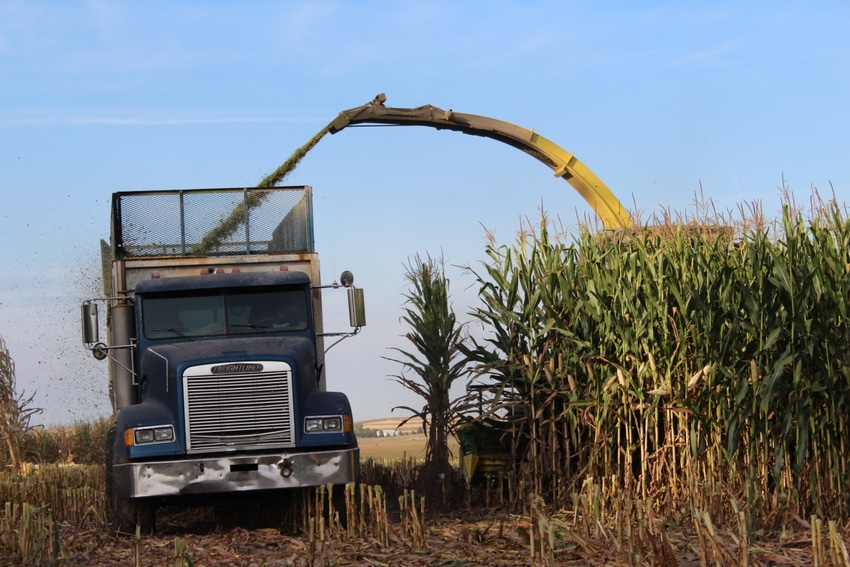Hitting outlined targets for harvesting corn intended for silage can offer dividends over subsequent year.
August 23, 2018

Midwestern corn intended for silage appears to be popping tassels at a fast pace in 2018. Thanks to early and steady rain throughout the growing season, great sunshine and heat, growing degree days have been prevalent and have lit a "planning for harvest" fire under many growers, according to an announcement from Rock River Laboratory in Wisconsin.
This preparedness always includes dry matter assessment in an effort to determine the chopping timeline.
“There are two reasons we are interested in dry matter (or moisture) of freshly chopped, whole-plant corn intended for silage: fermentation characteristics and crop maturity, assuming that dry matter correlates to kernel maturity,” explained Dr. John Goeser, animal nutrition, research and innovation director for Rock River Laboratory.
Goeser recommended reviewing university guidelines for ideal dry matter levels, dependent on storage type for a particular farm, but he offered a general guideline of 35% dry matter (65% moisture).
“Realizing that chopping can take some time, it’s best to begin the harvest just before you reach the dry matter target. Continue chopping beyond the target, and realize an average dry matter that is right around the ideal level,” he said.
As growers, nutritionists and agronomists prepare and assess the maturity of corn that may require an earlier harvest than normal, Goeser provided a few additional considerations and targets to achieve a good fermentation ahead and great feed to get through the next year:
1. Monitor crop maturity aggressively. Goeser recommended taking the time to monitor crop maturity regularly as the chopping season looms. In addition to dry matter measurement, a milk line and kernel maturity review can also be utilized to gauge crop progress, but moisture is still a strong component when it comes to fermentation characteristic assessment.
“The opportunity for failure or for challenges to arise is far greater when we aim for drier and more mature thresholds,” Goeser said. “It will be harder to pack and ferment at those drier levels. If we experience a dry spell with 80°F days and wind for a week, corn can go from drying out a point a day to losing several points of dry matter per day, leading to a fluffier crop (when harvested) that has kernels that are harder to process, among other detriments to the goal of an optimal feed.”
2. Include data from the InField Updates tool in the decision to chop. “Fiber and starch data provide direction as to the energy content per pound that the crop is going to have,” Goeser said. “We should shoot for more starch and less fiber, considering fiber is the least digestible nutrient out there, but it has to be balanced against dry matter. NDF [neutral detergent fiber] and starch determine potential nutritive quality, so I recommend less than 40% NDF. Hitting this target usually ensures starch greater than 32-35%.”
InField Updates is a free, crowdsourced, in-app tool from Rock River Laboratory that offers timely statistics on fresh dry matter, NDF and starch -- on a map -- to determine the optimal harvest timeline of corn intended for silage.
3. Consider high-cutting experiments. “Many areas experienced plenty of heat and moisture early in the growing season this year, so I’m forecasting fiber digestibility and stover characteristics to be more ‘woody’ this year,” Goeser said. “These characteristics can be varied with cutting height.”
He suggested that growers and their consultants prepare accordingly with an on-farm experiment when kernels are around half-milk line. Cut three to four stalks at a "normal" cutting height of 6-8 in., another set of stalks at 12-14 in. and one final set of stalks at 18-20 in. Then, chop the stalks and send them to the preferred laboratory for a forage analysis that includes NDF digestibility (NDFD).
Goeser said, “Two things will change with high cutting: first, fiber-to-starch ratio, because of more grain with less stover, and second, NDFD. The fiber portion at the top of the plant is more digestible than the lower section, so NDFD can be substantially improved by leaving the woodier portion in the field.”
4. Utilize KPS when chopping starts and throughout the harvest. Reviewing the kernel processing score (KPS) regularly throughout the harvest can help ensure kernel processing is up to par for optimal digestion, but the frequency is up to the grower and consultants.
“It’s one thing to have your equipment ready for the season, but changes happen in equipment and crop status, which affect KPS. Processing can be monitored by checking KPS once a day or even every couple of days,” Goeser said. “These samples can be sent to the lab for KPS analysis to check fields and keep the equipment processing correctly. Understand that the KPS benchmark is lower for unfermented, fresh-chop, whole-plant corn relative to what it will be six months into fermentation.
“Fresh-chopped corn KPS will improve as the fermentation process breaks down starch and the kernel more as time goes on. Thus, the fresh-chopped corn KPS goal is around 60-65, while fermented silage should be 75 or better,” Goeser advised.
To generally assess KPS without a lab, a simple float test can be performed. Drop 1 lb. of chopped corn into a bucket of water. The stover and leaves will float, with the crushed kernels ending in the bottom. Rinse the kernels through a screen to then assess visually. The recommended state after processing is complete kernel destruction.
Through careful assessment and utilizing the data available, nutritionists, agronomists and the growers they advise can optimize the chopping timeline. Goeser added, “Spending a short time now to dial in a balance of moisture level and nutritive qualities and harvesting at that appropriate time will pay back dividends in the form of an exceptional feed for the next 12-14 months.”
You May Also Like


.png?width=300&auto=webp&quality=80&disable=upscale)
